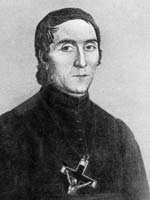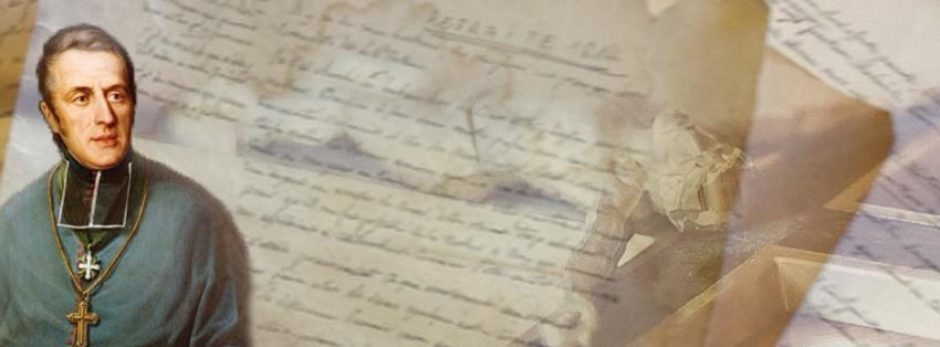Let’s pause in the narrative to study the figure of Father Guibert more closely.
 He was born in Aix-en-Provence, December 13, 1802 and entered the major seminary in Aix in 1819. Four years later he joined the Missionaries of Provence and made his oblation in 1823 and 1824 and on August 14, 1825, he was ordained to the priesthood in Marseilles by Bishop Fortuné de Mazenod.
He was born in Aix-en-Provence, December 13, 1802 and entered the major seminary in Aix in 1819. Four years later he joined the Missionaries of Provence and made his oblation in 1823 and 1824 and on August 14, 1825, he was ordained to the priesthood in Marseilles by Bishop Fortuné de Mazenod.
In 1826 he was appointed master of novices until 1828 when he was sent to Notre-Dame du Laus. For the next five years he was superior of the community, director of the Marian shrine and preacher of parish missions.
Yvon Beaudoin writes: “As superior of the major seminary of Ajaccio from 1835 to 1841, Father Guibert showed himself worthy of the confidence the Superior General had placed in him. In a few years, he succeeded in regaining possession of the former seminary and added three stories to it. The number of seminarians soon went from fifteen to more than one hundred with some competent professors, especially Father Albini for moral theology, Father Telmon for Sacred Scripture and Father Moreau for dogmatic theology. In order to obtain subsidies, Father Guibert often had to travel to Paris where he developed the acquaintance of and became friends with the government ministers and Louis-Philippe, the King. It was at this time that he displayed his talents as a diplomat in bringing about a reconciliation between Bishop de Mazenod and the King who wanted in no way to see a Bishop of Icosia in France, a bishop appointed in 1832 by Pope Gregory XVI without government authorization.
In Paris, the government, who, at the time, appointed the bishops, was not slow to look upon the superior of the seminary in Ajaccio as a candidate for a see. He was appointed to the see of Viviers. And on March 11, 1842, Bishop Eugene de Mazenod consecrated him bishop.”
As we will continue to reflect on the letters of St. Eugene, we will come across Fr. Guibert’s name very often. I thus only indicate a few events of his future life. He was Bishop of Viviers until 1857, and Archbishop of Tours until 1871, when he became archbishop of Paris unti his death in 1886. He was named a Cardinal in December 1873.
He was responsible for the building of the Basilica of the Sacred Heart in Montmartre in which he was buried in 1886
You can find many more details at https://www.omiworld.org/lemma/guibert-cardinal-joseph-hippolyte/

I think that somewhere along the way as I have listened to Eugene speak to us I have become a bit of a ‘history’ buff when it comes to Eugene, the Oblates and more lately members of the Mazenodian Family. I want to celebrate them and draw from their lives. Quite often when I am introduced to an Oblate I go to the Historical Dictionary – where we have been again invited to go to download the pieces about those early Oblates. They become like our daily bread which we chew on and swallow, making them a part of who we are.
I could not help but look at the picture of Guibert drawn by Yvon Beaudoin, a ‘sneak peek’; I noticed that he attended St. Sulpice when he was around 17 years old – the very place where Eugene had studied and allowed his heart to be formed (in my mind the image of a potter at the wheel is forming and reforming the one lump of clay).
It is interesting to watch and see the common characteristics within the early family of Oblates who were like-minded and “…apostolic men deeply conscious of the need to reform themselves, who would labour with all the resources at their command to convert others…” (Preface, OMI CC&RR); and yet each distinct in his own being. All with hearts shaped by the shared Charism of Eugene de Mazenod.
As I reflect on them, especially young Fr. Guibert I notice over and over how they join in communion with one another and am enchanted to see how this carries on through the ages right into the ‘now’ and towards the tomorrows. It is a ‘familial’ trait which must never be lost.
In a certain sense I find myself looking at the Mazenodian Family roots and the traits and gifts we share – with each other and all those we meet. I find myself filled with joy and also humility that I am one of the many invited to be a part of this family.
It is good to come here in this place, in communion with others with their lights being shed on each of us. A start to a special long weekend for us here in Canada. A Happy Canada Day to all!